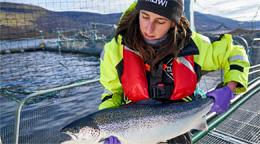Gutting Seafood Farming Deepens the Food Crisis

By SeaWestNews
Canada’s top food policy experts have just issued a blunt warning: protein prices are rising, food bank use is surging, and Canadians are increasingly struggling to afford the basics.
Yet as families across the country tighten their belts, the federal government is actively dismantling one of the most accessible and sustainable sources of protein we have — British Columbia’s salmon farming sector.
The central message in the newly released 2025 Canada’s Food Price Report is that we are heading deeper into a food affordability crisis, and homegrown solutions are more critical than ever.
With rising costs, disrupted supply chains, and growing demand for local food, Ottawa’s ongoing push to shut down B.C.’s ocean-based farms run directly counter to the report’s core findings.
If affordability, sustainability, and domestic food security are truly the goals, then killing off this science-backed, scalable seafood solution is not just bad policy, it is indefensible.
The report forecasts another increase in food prices this year, between three and five percent. For the average Canadian family of four, that translates into a grocery bill of more than $16,800.
Protein-rich categories like meat, seafood, and vegetables will bear the brunt of those increases. Beef prices alone are already up by more than nine percent, with supply further strained by the smallest cattle herd in Canada since 1987. Pork and poultry face similar constraints, and plant-based alternatives remain unaffordable for many households.
Seafood, by contrast, remains one of the few nutrient-dense, low-emission proteins that can be produced locally at scale. Yet rather than investing in this potential, the federal government continues to undermine it in an attempt to appease activist voices.
Over the past six years, production in B.C.’s salmon farming sector has dropped by 45 percent due to politically driven decisions that ignore peer-reviewed science.
Instead of supporting Canadian-grown salmon — the most popular seafood in the country — Ottawa’s actions have opened the door to imports flown in from abroad at higher prices and with a larger carbon footprint. The result is a lose-lose for affordability, sustainability, and food sovereignty.
This is happening while more than two million Canadians rely on food banks each month and nearly half of Gen Z is turning to savings or credit just to eat. These are not abstract statistics. They represent real families facing real hardship.
“Over 85 percent of Canadians say food costs have risen,” said Dr. Sylvain Charlebois, the lead author of the report produced in a collaboration between Dalhousie University, the University of Guelph, the University of Saskatchewan, and UBC.
“Our latest Food Sentiment Index highlights a clear uptick in consumer demand for locally produced food, especially in coastal regions like B.C. This trend aligns well with the growing visibility of local aquaculture.”
Charlebois added that seafood is still often perceived as a premium product. “Balancing affordability with sustainability and local sourcing could be key for the salmon sector’s future positioning.”
That balance already exists in British Columbia.
Ocean-raised salmon in B.C. requires no agricultural land and produces up to ten times fewer greenhouse gas emissions per kilogram of protein compared to traditional livestock. It uses significantly less freshwater than beef and delivers one of the highest protein yields per unit of environmental input.
It also supports Indigenous ownership, sustains thousands of jobs, and provides more than 380 million meals to Canadians every year.
In a world where food systems are strained by climate shocks and geopolitical conflict, B.C. salmon farming is exactly the kind of resilient, low-impact food solution Canada should be championing — not eliminating.
If given the chance, salmon farmers say they are committed to helping Canada lead the world in sustainable food production.
The sector has pledged $1.4 billion in direct investments to drive innovation, improve infrastructure, and implement next-generation technologies in partnership with First Nations. This bold strategy would support nearly 10,000 new jobs, deliver 380 million additional meals annually, and generate up to $44 billion in cumulative economic activity by 2050, all while helping Canada meet its emissions and reconciliation goals.
This is not just about economics. It is about values.
It is about feeding Canadians with clean, local food grown in collaboration with Indigenous communities. And it is about responding to a food affordability crisis not with slogans, but with solutions that already exist.
In the context of providing Canadians with affordable and sustainable seafood, the solution is here. It is local. It is led by First Nations. It is proven. And it is ready to grow.









